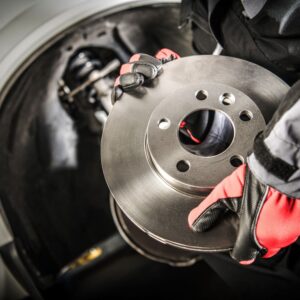Dry-ice cleaning is a cleaning process that forces dry ice pellets across a surface or material at high speeds using compressed air. The process is very similar to sandblasting or soda blasting. However, dry-ice cleaning has distinct differences, offering several advantages and disadvantages.
Unlike other cleaning methods that use abrasive particles like sand or glass, dry ice doesn’t leave a mess. Dry ice is made from carbon dioxide, so once it’s shot out with compressed air, the dry ice almost instantly sublimates back into gas.
What Is Dry-Ice Cleaning Used For?
You can think of dry-ice cleaning as more akin to pressure washers than sandblasting because it can be used to clean grease, grime, and oil from surfaces like rubber and plastic. Does dry-ice cleaning remove rust? It certainly can. Using dry ice to remove rust has a significant advantage over sandblasting because it doesn’t impact or abrade metal surfaces. However, dry-ice cleaning can only remove the thin, top layer of rust. If a component has developed a deep layer of rust, then dry-ice cleaning is ineffective.
Dry-ice cleaning can be beneficial when it comes to cleaning sensitive components like microchips. Unlike sandblasting or soda blasting, dry-ice cleaning isn’t abrasive enough to remove paint. On the other hand, dry-ice cleaning is abrasive enough to give soft materials a smooth finish.
This is why dry-ice cleaning is used to make molds for metal components.
How Does Dry-Ice Cleaning Work?
Like other blasting media, dry-ice cleaning uses the pressure from blasting the super-cold material to clean surfaces. How does dry ice clean materials from dirt, rust, and other debris? It’s very simple. Much like blasting a surface with water, the pressure from the dry ice’s impact blows the contaminants away. However, unlike a pressure washer that gets the object wet, dry ice cleaners don’t leave any residue.
Dry-ice cleaning requires good ventilation so that the carbon dioxide gas from the dry ice doesn’t accumulate and asphyxiate the worker.

Downsides of Dry-Ice Cleaning
Dry-ice cleaning might have some advantages, but it also has a lot of drawbacks. Firstly, dry ice is hard to source and difficult to handle. Dry ice needs to be cooled to -109.3 degrees Fahrenheit before carbon dioxide solidifies. Hence, tiny dry ice pellets need to be specially produced and stored. Afterward, dry ice needs to be kept in an isolated environment so that it doesn’t absorb heat and turn back into gas.
Handling dry ice is challenging because it can cause cold burns if it comes into contact with the skin. The user will need a dry ice container to transport the cold substance from the source to where it’s going to be used. Dry ice also needs to be in a ventilated container, since an air-tight container can explode. Additionally, the container must be kept in a ventilated environment because carbon dioxide can accumulate in small rooms and asphyxiate people.
Dry ice needs to be pushed out of a hose with high-pressure air. Dry-ice cleaning also requires more powerful air compressors since the pressure required to achieve the intended rust-cleaning effects is almost double that of sandblasting. Lastly, dry-ice cleaning is incredibly noisy, so people will need ear protection during the process.
Overall, dry-ice cleaning’s non-abrasive nature makes it a valuable tool for cleaning delicate surfaces without leaving a mess. However, the challenges associated with handling and sourcing dry ice, coupled with the need for specialized equipment and precautions, make dry-ice cleaning tedious and complex. At the end of the day, dry-ice cleaning can still be a compelling alternative to sandblasting and other types of cleaning.
Any information provided on this Website is for informational purposes only and is not intended to replace consultation with a professional mechanic. The accuracy and timeliness of the information may change from the time of publication.



















